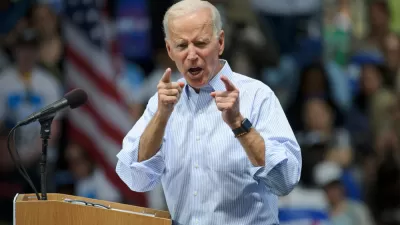With energy and the economy both causing headaches, 2008 has been a big year for local governments recognizing and planning for peak oil. Finding a way forward in a future of constrained energy will require much of planners.
"2008 was a big year for government responses to peak oil. Post Carbon Cities, which tracks local government responses to the issue, has added a number of new towns -- not just the "usual suspects" -- to its list. But the bill is rapidly coming due on our "energy gluttony problem," and U.S. cities are left bedecked with infrastructure that requires cheap, easy energy.
The way ahead is not obvious for either planners or government officials. Planning and engineering practice is still rooted in a 20th-century mindset that assumes energy --and especially gasoline-- will be readily available and affordable for decades to come. As decades-long trends of both suburbanization and globalization come up against the resource limits of the 21st century, we'll have to move quickly to adjust to the new rules.
One of those new rules was explained succinctly by Bloustein School of Planning (Rutgers University) Dean James Hughes this past June: 'Distance matters.' If 2008 turns out to be the year that the big post-war economic and development trends finally came to an end, perhaps it will also be the year that we finally stopped pretending that distance didn't matter."
FULL STORY: Post Carbon Cities 2008 Year in Review

Alabama: Trump Terminates Settlements for Black Communities Harmed By Raw Sewage
Trump deemed the landmark civil rights agreement “illegal DEI and environmental justice policy.”

Planetizen Federal Action Tracker
A weekly monitor of how Trump’s orders and actions are impacting planners and planning in America.

The 120 Year Old Tiny Home Villages That Sheltered San Francisco’s Earthquake Refugees
More than a century ago, San Francisco mobilized to house thousands of residents displaced by the 1906 earthquake. Could their strategy offer a model for the present?

Indy Neighborhood Group Builds Temporary Multi-Use Path
Community members, aided in part by funding from the city, repurposed a vehicle lane to create a protected bike and pedestrian path for the summer season.

Congestion Pricing Drops Holland Tunnel Delays by 65 Percent
New York City’s contentious tolling program has yielded improved traffic and roughly $100 million in revenue for the MTA.

In Both Crashes and Crime, Public Transportation is Far Safer than Driving
Contrary to popular assumptions, public transportation has far lower crash and crime rates than automobile travel. For safer communities, improve and encourage transit travel.
Urban Design for Planners 1: Software Tools
This six-course series explores essential urban design concepts using open source software and equips planners with the tools they need to participate fully in the urban design process.
Planning for Universal Design
Learn the tools for implementing Universal Design in planning regulations.
Clanton & Associates, Inc.
Jessamine County Fiscal Court
Institute for Housing and Urban Development Studies (IHS)
City of Grandview
Harvard GSD Executive Education
Toledo-Lucas County Plan Commissions
Salt Lake City
NYU Wagner Graduate School of Public Service





























